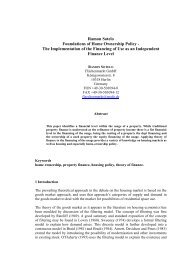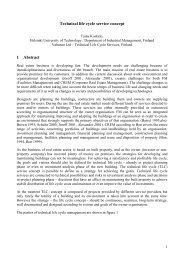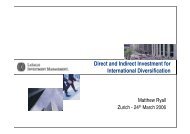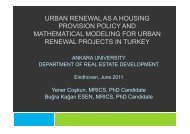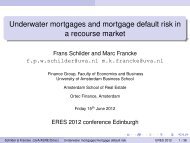Adding Value Through CREAM Alignment
Adding Value Through CREAM Alignment
Adding Value Through CREAM Alignment
You also want an ePaper? Increase the reach of your titles
YUMPU automatically turns print PDFs into web optimized ePapers that Google loves.
<strong>Adding</strong> <strong>Value</strong> <strong>Through</strong> <strong>CREAM</strong> <strong>Alignment</strong> 2012AbstractPurpose: This paper aims to evaluate the relationship between corporate strategy andCRE strategyDesign/methodology/approach: The paper will identify, and evaluate, a number ofcomponents that collectively form the CRE strategy. Linkages between the businessenvironment, the aims and objectives of the organisation and the real estate solution willbe explored.Findings: The paper will illustrate the alignment of the CRE strategy to the corporatestrategy through the development of a CRE alignment model. The model willdemonstrate that only when optimum alignment is achieved can the CRE strategy deliveradded value and enhanced organisational performance.Practical Implications: CRE managers can use the model to evaluate the alignment oftheir CRE strategy with their corporate strategyOriginality/<strong>Value</strong>: The paper fills a void by proposing a framework that seeks to identifythe true impact of real estate to business by examining the benefits of optimal alignmentbetween, planet, position, purpose, place, paradigm, processes and people to produceperformance and productivity.IntroductionOver the last 20 years there has been a clear development, both in academic andprofessional terms, in Corporate Real Estate Management (CREM). CREM hasdeveloped into a strategic management discipline that requires the same amount ofattention as other strategic disciplines. The primary aim of CREM is to enhance theperformance of the client organisation through the alignment of the corporate real estate(CRE) strategy with the organisational strategy.Haywood (2011) reviewed the CREM literature to evaluate theoretical models that haveattempted to establish the linkage between CREM and organisational strategy. Haywood(2011) makes the point that the existing approaches to CRE alignment tend to fall intoone of two camps. The alignment models are either single CRE factor or are multivariatealignment models (Heyward 2011). Heywood (2011) identified 10 different alignmentmodels which included components ranging from 7 to 15. Whilst the multivariateapproach may offer a more detailed understanding of the relationship between CRE andorganisational strategy it also raises a number of fundamental questions:• What are the components of CREM?• What would be an appropriate theoretical framework for CREM?• And, how do these components interact in a multivariate way?This paper aims to address the first two questions with the third question being left forfuture research. The proposed alignment model is contained in Figure 1. The premise of2 | P a g e



